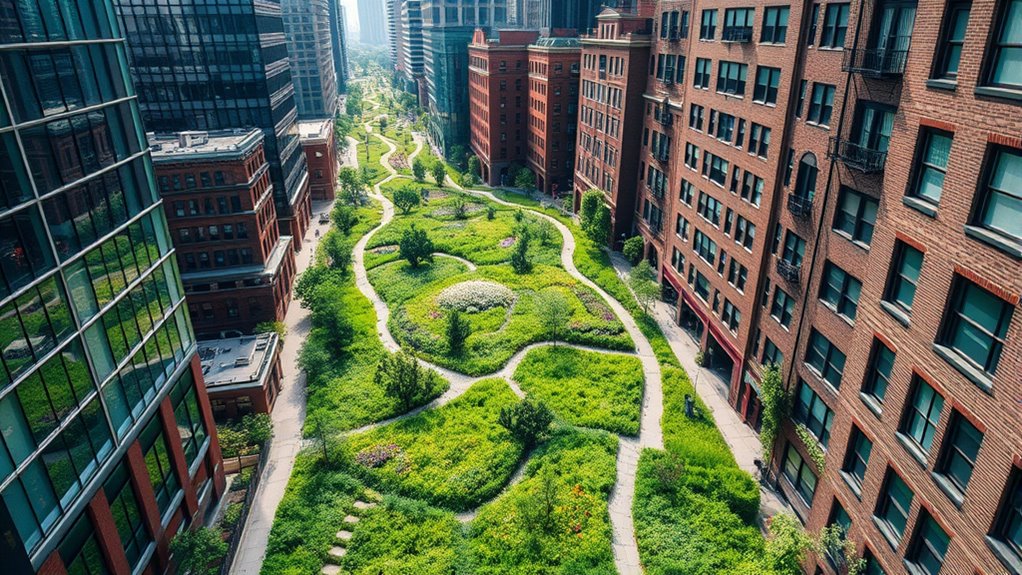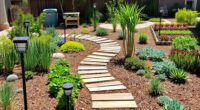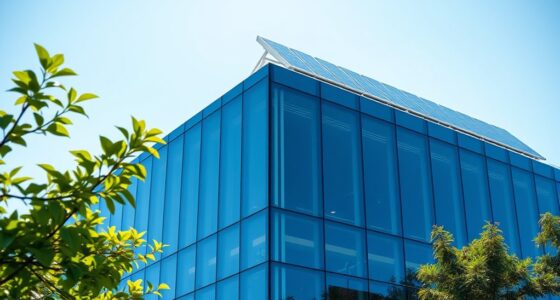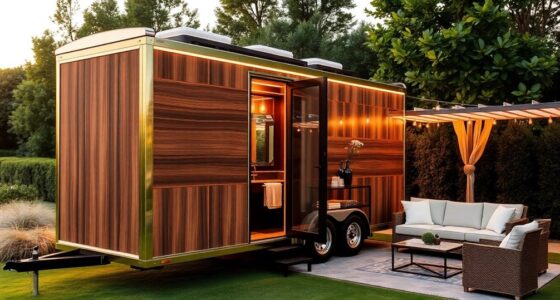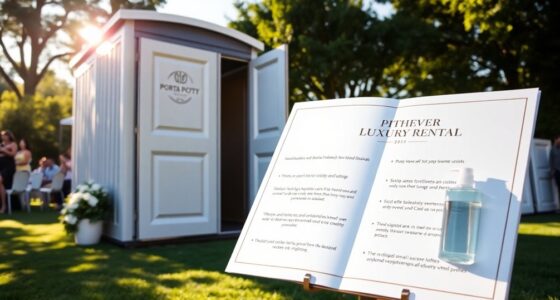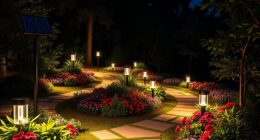Urban biodiversity corridors are essential pathways that connect green spaces throughout your city, allowing wildlife to move freely and thrive. By incorporating native plants in parks, gardens, and green rooftops, you create crucial habitats that support local insects, birds, and small mammals. These corridors help prevent habitat fragmentation and improve ecological health. As you explore further, you’ll discover how these natural connections can transform your city into a more vibrant and resilient urban environment.
Key Takeaways
- Urban biodiversity corridors connect green spaces, enabling wildlife movement and preventing habitat fragmentation in cities.
- Native plantings support local insects, birds, and mammals, enhancing urban ecological networks.
- Green rooftops create elevated habitats, linking ground-level green spaces across city landscapes.
- Ecological corridors facilitate gene flow and species adaptation amid urban development pressures.
- Implementing these corridors fosters resilient, biodiverse urban ecosystems and encourages community engagement with nature.
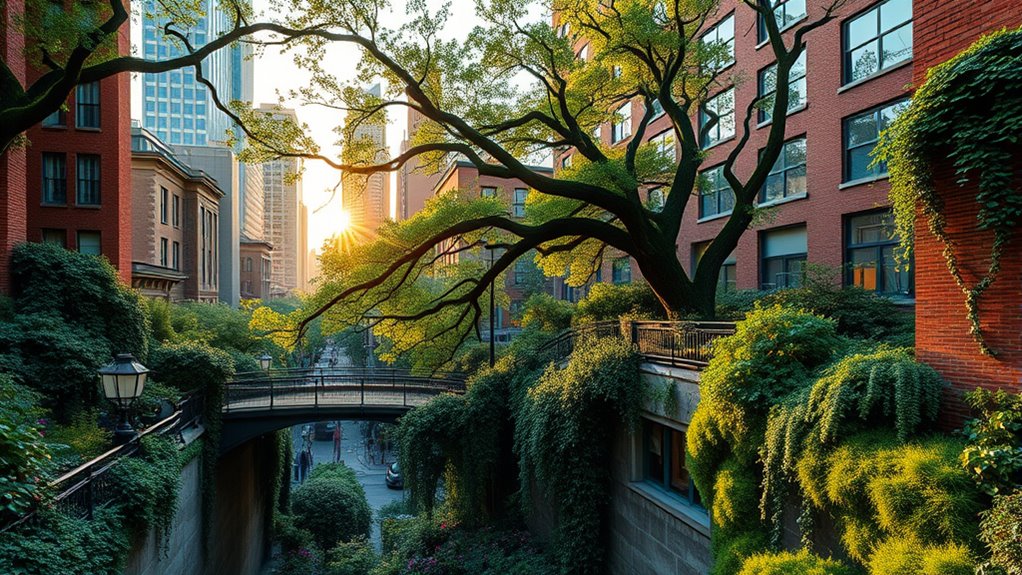
Urban biodiversity corridors are essential pathways that connect green spaces within cities, allowing wildlife to move safely across developed areas. These corridors serve as vital links that prevent habitat fragmentation, giving animals and plants a better chance to thrive amid urbanization. As you consider ways to make your city more wildlife-friendly, think about how native plantings and green rooftops can play a pivotal role. Native plantings are tailored to local ecosystems, providing food and shelter that support native insects, birds, and small mammals. By incorporating these plants into parks, median strips, or even private gardens, you create stepping stones that wildlife can use to navigate the urban landscape. These plantings not only foster biodiversity but also require less maintenance and water, making them a sustainable choice for city environments. Supporting ecological networks is fundamental to maintaining resilient urban ecosystems.
Native plantings create vital links that support urban wildlife and foster biodiversity in city landscapes.
Green rooftops further enhance these corridors by transforming unused roof spaces into thriving ecosystems. When you install vegetation on rooftops, you’re creating elevated habitats that connect ground-level green spaces with higher elevations, forming a layered network for wildlife movement. Green rooftops help mitigate the heat island effect, improve air quality, and reduce stormwater runoff, all while supporting biodiversity. By designing these rooftops with native plantings, you ensure that the plant species are well-adapted to the local climate and soil conditions, increasing their chances of survival and attracting native pollinators like bees and butterflies.
Together, native plantings and green rooftops turn otherwise overlooked spaces into ecological corridors, facilitating movement and gene flow among populations. This connectivity is especially crucial in cities with dense development, where natural habitats are often isolated and shrinking. As you participate in or advocate for urban planning that emphasizes these features, you’re actively contributing to a more resilient and biodiverse cityscape. You might notice birds nesting in green rooftops or pollinators thriving in native plant gardens, which indicates a healthier urban ecosystem. Creating these connections isn’t just about aesthetics; it’s about ensuring that urban environments support a wide range of species, maintaining ecological balance and enriching your quality of life.
In essence, by integrating native plantings and green rooftops into city planning, you’re laying down the foundation for vibrant biodiversity corridors. These corridors help wildlife adapt to urban challenges, while also offering residents more opportunities to connect with nature. The result is a city that’s not only more sustainable but also more alive, with a dynamic web of green pathways that weave through concrete and steel, revealing the wild potential hiding in plain sight.
Frequently Asked Questions
How Do Urban Biodiversity Corridors Impact Local Air Quality?
Urban biodiversity corridors improve local air quality by promoting air purification and reducing pollution. When you incorporate green spaces and plant life, they act as natural filters, absorbing pollutants and releasing clean oxygen. These corridors also help decrease the heat island effect, which can worsen air pollution. As a result, you experience fresher air, healthier environments, and a more sustainable city, making urban living more comfortable and eco-friendly.
What Are the Costs Associated With Creating Biodiversity Corridors?
Imagine spending around $250,000 per mile to create biodiversity corridors. You should consider the cost analysis, which includes initial construction and ongoing maintenance expenses. These costs cover planting native species, habitat management, and infrastructure upkeep. While the investment can seem high, the ecological benefits often outweigh expenses, promoting urban wildlife and improving city life. Planning carefully helps you balance costs with the positive environmental impact.
Can Urban Corridors Support Endangered Species Effectively?
You might wonder if urban corridors can support endangered species effectively. They enhance wildlife connectivity, allowing animals to move safely between habitats. By focusing on habitat restoration within these corridors, you create safe spaces that meet the needs of endangered species. While challenges exist, properly designed urban corridors can provide critical refuge, promote genetic diversity, and boost population resilience, making them a essential tool in conservation efforts in city environments.
How Do Residents Typically Respond to New Biodiversity Corridors?
Imagine you’re stepping into the future, where residents often respond positively to new biodiversity corridors. You’ll find that community engagement plays a crucial role, fostering support and awareness. People appreciate aesthetic integration, as these corridors enhance urban beauty and provide green spaces. While some might initially be skeptical, most become advocates, understanding how these corridors contribute to ecological health and community well-being. Your involvement helps make these projects successful and cherished.
Are There Successful Global Models of Urban Biodiversity Corridors?
You’ll find that successful global models of urban biodiversity corridors focus on green infrastructure and enhancing ecological connectivity. Cities like Singapore and Copenhagen have integrated these corridors into their urban planning, creating green spaces that connect habitats and support wildlife. These models show that with strategic design and community involvement, you can boost biodiversity, improve air quality, and foster a healthier urban environment. Emulating such initiatives benefits both nature and residents.
Conclusion
Imagine walking through a city where birds sing from hidden green passages, much like secret garden roads connecting nature’s heart to urban life. By creating biodiversity corridors, you’re not just adding trees—you’re weaving a vibrant, living tapestry that supports wildlife and enriches your daily experience. Studies show cities with these corridors see a 20% increase in urban biodiversity. So, embrace these wild pathways; they’re your city’s secret lifelines, waiting to flourish right beneath your feet.
